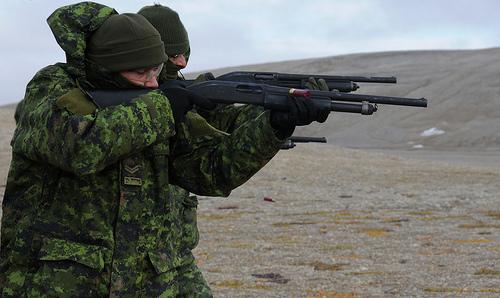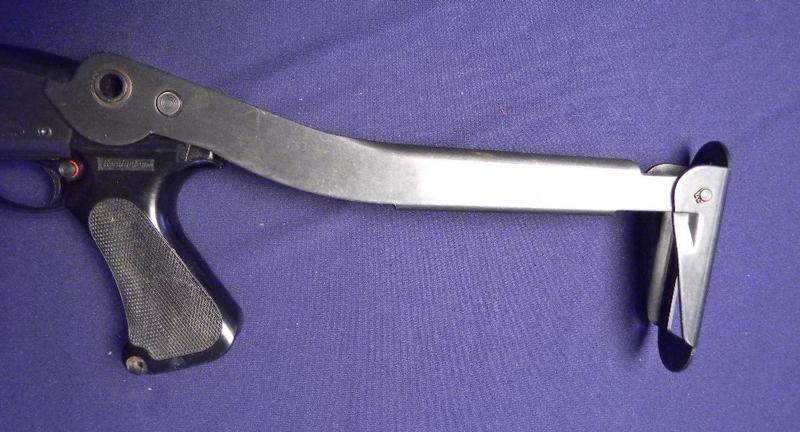-
FREE MEMBER
NO Posting or PM's Allowed

Remington 870 current military issue
What are the martial markings on the current 870's with the composite stock and fore end? A friend of mine works in a AF armory and he said they just received 4 racks of 870's with dark gray stocks and fore ends. When did they start using the composite stocks. He is on leave now.
Information
 |
Warning: This is a relatively older thread
This discussion is older than 360 days. Some information contained in it may no longer be current. |
|
-
07-31-2016 11:57 PM
# ADS
Friends and Sponsors

-
Legacy Member

What I could find out the USAF is using the 870 MCS my friend told me he didn't see any markings on the guns other then the factory markings.
-
-
Advisory Panel


Same with the Canadian guns...nothing special reported. Let me get one more man involved here, he may have info...wait, out...
guns...nothing special reported. Let me get one more man involved here, he may have info...wait, out...
-
-
Legacy Member

Speaking to Canadian Service shotguns, we had no additional military stampings, proofs, or identification markings, they were only marked with Remington roll marks and typical serial numbers.
Service shotguns, we had no additional military stampings, proofs, or identification markings, they were only marked with Remington roll marks and typical serial numbers.
During my time (subject to change with modernization) we had the Remington 870P (Police) parkerized finish with composite stocks. 12 guage, 3" chambers, cylinder bore, bead sight. barrels at 18" if memory serves. Two butt stocks were offered, the typical fixed composite, and the over top steel folder with pistol grip.
Identifying a former service one in the future will be difficult because only the serial number records will tell you if was a CF gun, but due to currently policy it should be fairly easy as all former CF weapons are to be destroyed and not sold out of service.


Additional remarks.
The LOP was too long for anyone under 6'2" to shoot properly with body armour on, personally I couldn't even shoulder the weapon while wearing plates, well I could, but then I couldn't reach the pump with the supporting hand, it looked comical I must say...
The folding steel stock was the worst thing I have ever tried to shoot with, I would rather be hit in the head with an entrenching tool than do another "Jungle Lane" range with one of those.
There was a great deal of mistrust of these shotguns, first because of a warning officially issued around 2004 that stated our shotguns were found to discharge if at the ready (shell chambered) and the weapon suffered a short fall (drop) onto the butt, secondly due to lacking a removable magazine the positive clearing of the weapon became different than most weapons, which lead to a run of ND's among less diligent soldiers unaccustomed to shotguns in their former civilian life.
During my tour to Afghanistan in 2006 our shotguns were issued with #7 birdshot high brass loads, since there were few upland game birds in the desert, this ammunition became a running mockery of the supply system among knowledgeable shotgunners.
Shotguns did not really see widespread service, they were issued during special situations and during operations generally rode inside the LAV 3 and were used to provide a measure of "seriousness" to leaders meetings (Shura) after Captain Greene was nearly killed with an axe during one these kinds of meetings.
I will find some period photos from my collection to share.
I see from the internet, different types of shotguns have entered service, some are 870P with extended tubes, sights, or flashlight pumps, the JTF2 apparently has a Benelli but that is outside my immediate scope of knowledge.
- Darren
1 PL West Nova Scotia Regiment 2000-2003
1 BN Princess Patricia's Canadian Light Infantry 2003-2013
-
The Following 3 Members Say Thank You to Sentryduty For This Useful Post:
-
Advisory Panel


Sad for us that we never have focused on usability from the outset. There are collapsible stocks that go right on for immediate use. Here's one example...
It's like the C7 with the solid butt, too long for the later use. No forethought whatsoever.
-
-
Legacy Member

The Remington 870 MCS Modular Combat Shotgun has a 10"barrel a 14"barrel and a 18"barrel also comes with a fixed butt stock a collapsible butt stock and a pistol grip in which the butt stocks slides into a dovetail and held in place by a pin which makes for a quick and easy stock change
-
-
Legacy Member

Couple of photos of CF Remington 870P shotguns in Afghanistan 2006, from my personal archives:
Attachment 76761Attachment 76762
- Darren
1 PL West Nova Scotia Regiment 2000-2003
1 BN Princess Patricia's Canadian Light Infantry 2003-2013
-
The Following 2 Members Say Thank You to Sentryduty For This Useful Post:
-
Legacy Member

I guess a shotgun would be quite useful in CQB events, but not so much on the Kipling-esque "Afghanistan's Plains".
I spotted the knee protectors in the first pic, so, is that a "displaced" kneepad I see in the second pic?
Looking at that terrain, it should be obvious that knee and elbow pads are essential accessories for combat in the giant rock-garden that is Afghanistan.
Probably also useful for when dealing with the "bureaucracy".
-
-
Advisory Panel



Originally Posted by
Bruce_in_Oz

is that a "displaced" kneepad I see in the second pic?
Yes it is, and they're something we needed 40+ years ago. I'd have less knee problems now.
-
-
Legacy Member


Originally Posted by
Bruce_in_Oz

I spotted the knee protectors in the first pic, so, is that a "displaced" kneepad I see in the second pic?
Looking at that terrain, it should be obvious that knee and elbow pads are essential accessories for combat in the giant rock-garden that is Afghanistan.
Sharp eye Bruce, we finally, and I mean "finally!" were issued knee and elbow protection in 2005, there were two variations. The CADPAT green ones shown in the first photo man on the left, and off the shelf pieces by "Hatch" worn by the man on the right. I got a full set of Hatch (knee and elbow) issued to match the set I had been wearing for years. I never got the CADPAT ones for some reason, perhaps I declined to go to get issued those ones, cannot recall. There were varying opinions about which ones were best, but most guys, including me, found the CADPAT ones to be bulky and more restrictive.
In the second photo you will notice that Cpl. M (Still serving, a Sergeant now.) has only one and it is rotated to the ankle, this was a common practice, in an effort to reduce weight and bulk, only the dominant knee pad was worn, and when not in immediate use was rotated to the side and placed by the ankle, in the "travel position" as wearing such pads did cut off blood flow on long marches. The CADPAT pads could not be used in this way, they were constructed more like sports equipment, hockey gear comes to mind.
Almost no one wore the elbow pads during my time, they weren't worth the weight and bulk, and the majority of knee pad use was seen during tactical pauses when patrolling (take a knee and cover the arcs) or when firing from the kneeling position. Kneeling on rocky Afghan soil without pads, given our packed loads at times would feel like dropping a knee into a box of construction nails.
As any current or retired Infantry Soldier reading is nodding sagely, there is good reason why every Infantryman has ruined knees, feet, and back, and generally survives on Ibuprofen. The stuff you don't worry about when you are 18 sure does catch up when you get just a few years older.
- Darren
1 PL West Nova Scotia Regiment 2000-2003
1 BN Princess Patricia's Canadian Light Infantry 2003-2013
-
The Following 2 Members Say Thank You to Sentryduty For This Useful Post:















 Register To Reply
Register To Reply











